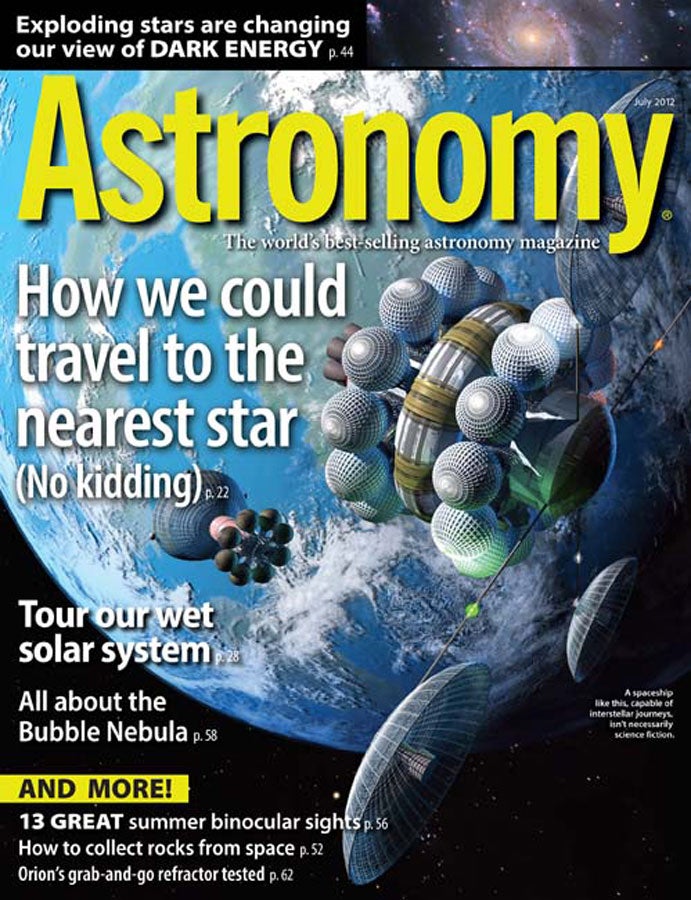
WAUKESHA, Wis. — It’s no secret that one day humans will have to leave Earth behind. Whether it’s from a major asteroid impact, or simply the Sun’s ever-warming radiation, our world eventually will become uninhabitable, and our species must learn to travel to other worlds if it is to survive. Such a voyage, over trillions of miles and kilometers, seems impossible, an idea worthy only of science fiction or of the unimaginable future. But is it really?In “How humans will travel to Alpha Centauri,” Associate Editor Bill Andrews lays out the present-day hurdles involved in an interstellar journey and how modern engineering can overcome them. “Let’s not be too quick to discount our real achievements,” he writes. “In just over 100 years, our species has learned how to fly, how to launch into space, and how to begin working and living there.” Perhaps the next giant leap will just be a matter of time.Still, a trip to our nearest star, a red dwarf called Proxima Centauri that’s likely a member of the Alpha (α) Centauri system, runs some 24.7 trillion miles (39.9 trillion kilometers) each way. Getting there requires not only ingenious methods of propulsion and a minimum of decades en route, but also a sophisticated system of life support for the human crew to survive the journey. The costs and difficulties aren’t insurmountable, but they would require almost unparalleled public and governmental support, making the ultimate question not “could we?” but “should we?”Pick up the July issue of Astronomy, on newsstands June 5, to learn more about what it would take to travel to another star.
“Tour our wet solar system”
In “Tour our wet solar system,” frequent contributor Michael Carroll describes the various forms and locations water can take throughout our cosmic neighborhood. The plethora of probes scientists have launched “unveil an astonishing spectrum of H2O in a variety of environments, but certainly not a drop to drink,” he writes. It turns out remote areas of the solar system practically brim with the stuff, making Earth’s cache of water a mere drop in the bucket. From the ancient oceans on Mars, to the soaking rings of Saturn, past the frozen moons of the gas giants, and out to the icy realm of comets, water proves itself nearly ubiquitous. It helps tell the story of the planets’ past and might give hints to our species’ future.
“13 great summer binocular sights”
Put away your telescope for the night and let Contributing Editor Phil Harrington take you on a tour of “13 great summer binocular sights.” This time of year, it’s fun to spend time outdoors both day and night. Whether it’s a double star, nebula, or star cluster, each of these 13 targets proves that “summer nights are made for observing, especially through binoculars.”
“Astronomy tests Orion’s grab-and-go refractor”
Steve Edberg writes, “Right out of the box, this telescope is impressive,” in “Astronomy tests Orion’s grab-and-go refractor.” The ED102T CF Triplet 4-inch apochromatic refractor boasts elegant construction, powerful optics, and a “ ‘fast’ system that offers a wide field of view for visual observing or astrophotography.”
July night-sky events visible without optical aid
- July 14 — The Moon passes 0.5º north of Jupiter.
- July 15 — The Moon passes 4º north of Venus and lines up between our sister planet and Jupiter.
- July 24 — The Moon passes 4º south of Mars.
- July 25 — The Moon passes 6º south of Saturn.
- July 29/30 — The Southern Delta Aquarid and Alpha Capricornid meteor showers peak with up to 25 meteors per hour.
Also in the July 2012 Astronomy
- “Dark energy’s new face” — How are exploding stars changing our view of the universe’s mysterious force?
- “How to collect rocks from space” — Start a meteorite collection and soon you’ll be holding a piece of solar system history in the palm of your hand.
- “All about the Bubble Nebula” — Check out this emission nebula in Cassiopeia to see the results of a massive star’s hurricane-force winds.
- “The Sky this Month” — Exclusive star charts will guide you through the night sky.
- The July issue of Astronomy also includes Astro News, Bob Berman’s Strange Universe, Glenn Chaple’s Observing Basics, Stephen James O’Meara’s Secret Sky, Tony Hallas’ Imaging the Cosmos, Ask Astro, Deep-sky Showcase, New Products, Reader Gallery, and The Cosmic Grid.









